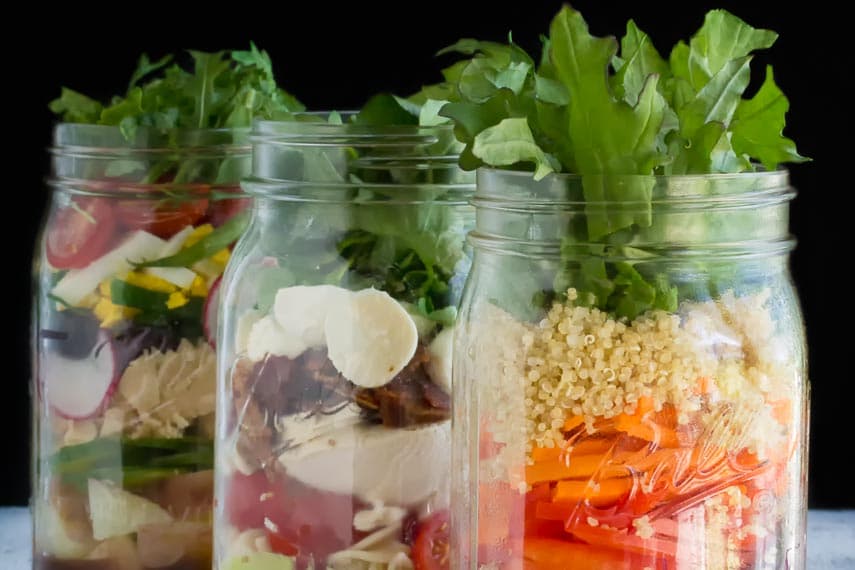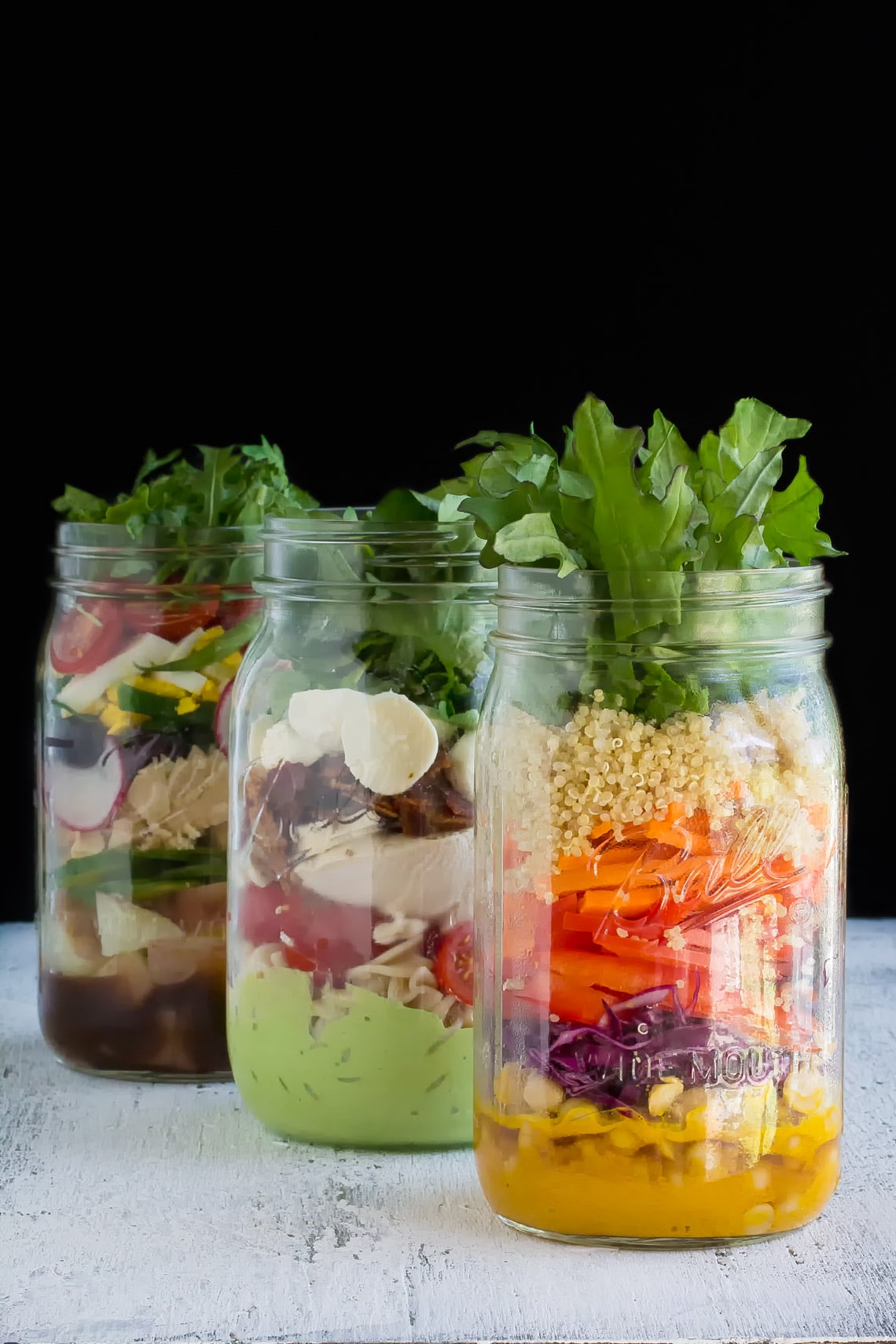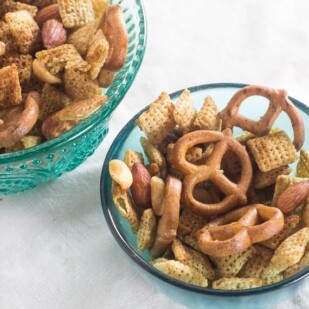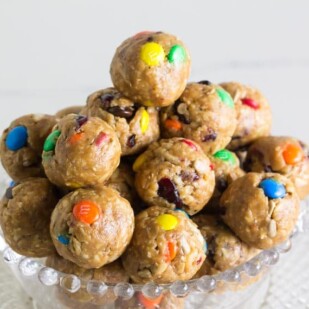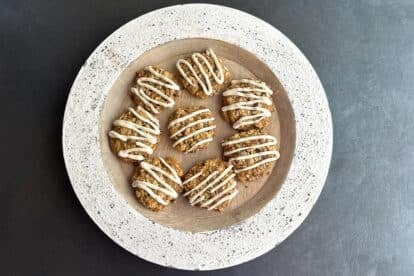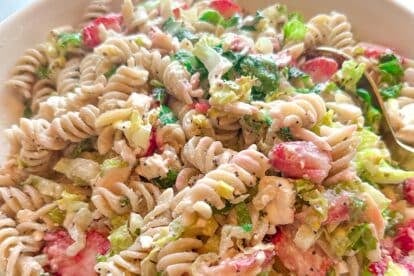Easy Low FODMAP Mason Jar Salads
A few years ago it seemed as if every food blogger was going Mason jar crazy. It’s a funny thing when something as old-fashioned as a Mason jar gets a new life, but in this case it made sense.
These mason jars are accessible, inexpensive and work well at holding everything from salad to dish soap. Let’s make low FODMAP Mason Jar Salads!
Let’s Make Low FODMAP Mason Jar Salads!
Let’s focus on the salads, shall we? Images abound all over the Internet of amazing looking salads layered up in Mason jars and we wanted to give them a FODMAP makeover.
They are certainly easy enough to make, but it is also easy to add too much of this or that and end up with a higher FODMAP creation than intended. Do pay attention to recommended portions of ingredients and serving sizes.
We highly recommend that you use the Monash University App to help guide you with portion decisions and remember that you are combining many items in one meal.
We have called out some specific amounts where we think it is easy to over-indulge.
STACKING!
The thing to watch out for when creating your Mason Jar Salads is that it is easy to go overboard and end up stacking FODMAPs.
Simply put, this is what that means: let’s say you know that you can tolerate a certain level of fructans, like the fructans in cabbage. And then let’s say you also know what your tolerance level is for the fructans in zucchini. Well, if you layer both of those items in one jar at your tolerated amounts, you will have stacked the fructan amounts and overloaded your system, possibly triggering symptoms. So take care!
Be Creative
The purpose of this recipe is to inspire you and help you to create and customize your own salad.
Choose at least one protein, one green, one grain, perhaps two veggies, possibly a fruit, something crunchy like nuts or seeds and maybe also a cheese.
Think about color, texture and of course, flavor. The dressing goes on the bottom to keep your upper layers as fresh and crisp as possible.
You can empty into a bowl, toss and eat or if your jar is roomy enough, shake up the ingredients and dig right in.
Can These Mason Jar Salads Be Dairy-Free? Gluten-Free? Vegan?
Of course, these might be – or might not! It will depend on your choices.
Please note that the calorie count is an approximation, as every Mason Jar Salad will be different.
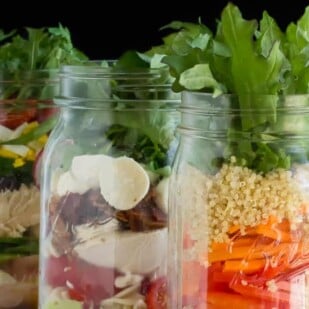
Low FODMAP Mason Jar Salads
Low FODMAP Mason Jar Salads are easy - and fun! - to make and can be tailored to your liking.
Ingredients:
Dressing (consider 2 tablespoons to start):
- Red Wine Vinaigrette
- Sherry Vinaigrette
- Low FODMAP Caesar Salad Dressing
- Low FODMAP Green Goddess Salad Dressing
- Your low-FODMAP dressing of choice, such as a simple combination of fresh lemon juice or low FODMAP vinegar and olive oil
Protein:
- Cooked chicken, shredded or chopped, poached or roasted, such as from our Low FODMAP Recipe for Orange Rosemary Roast Chicken Turkey, shredded or chopped
- Ham or roast beef, diced or julienned
- Canned and drained salmon or tuna, or leftover cooked fish, flaked
- Cooked shrimp, diced
- Crumbled crisp cooked pork or turkey bacon, choose gluten free if on a gluten free diet
- Hardboiled egg, diced or sliced
- Firm or extra firm tofu, cubed, raw or cooked
- Tempeh, crumbled or cubed, raw or cooked (avoid those with high FODMAP ingredients)
- Canned drained and rinsed butterbeans, up to ¼ cup (35 g) or chickpeas up to ¼ cup (42 g)
- Canned drained and rinsed lentils, up to ½ cup (46 g)
- Freshly cooked red or green lentils, up to ¼ cup (23 g)
Cooked Grain:
Cheese & Dairy:
- Blue cheese, crumbled
- Feta or goat cheese, crumbled diced or shredded
- Brie or Camembert, cubed
- Mozzarella, small balls or shredded or finely diced
- Cheddar, Havarti, Gruyere, Monterey or Pepper Jack, or Swiss cheese, shredded or finely diced
- Parmesan, shaved or grated
- Lactose-free yogurt
- Lactose-free sour cream
Veggies, Hard & Soft:
- Alfalfa or mung bean sprouts
- Avocado, diced or sliced, up to 30 g per serving
- Beets, raw or cooked, up to 1 tablespoon shredded or 2 slices
- Bell peppers, slivered or chopped
- Bok choy, raw or cooked, chopped or sliced
- Broccoli florets, blanched or raw
- Carrot, raw or cooked, shredded, julienned or finely chopped
- Celery, up to 2-inches (5 cm) of stalk, chopped
- Celery root, blanched, shredded or diced
- Corn kernels, fresh of the cob, up 38 g
- Cucumber, sliced or chopped, preferably English hothouse style
- Fennel, raw or cooked, finely sliced or chopped
- Green beans, blanched or raw, whole or chopped
- Potatoes, white, red or yellow, cooked, chopped or sliced
- Radishes, sliced or chopped
- Scallions, green parts only
- Tomatoes, chopped or sliced or whole or halved cherry or grape tomatoes
- Water chestnuts, sliced or chopped
- Zucchini, blanched or raw, sliced or cubed
Greens:
- Romaine, Boston, butter, red leaf, green leaf, radicchio or Iceberg lettuce, shredded, torn or chopped
- Green or red cabbage, shredded or chopped
- Kale, raw or cooked, chopped or shredded
- Chicory, endive, or watercress chopped or torn
- Spring lettuce mix and/or baby spinach or arugula
Fruit:
- Note: You can use the full amount listed below or use a half portion to allow for a half portion dried fruit or skip the fresh and only use dried fruit or visa versa. Remember to stick with one fruit serving per meal. For example you could use 5 raspberries and ½ tablespoon of raisins.
- Strawberries, up to 10 (140 g), chopped or sliced
- Blueberries, up to 20 (28 g)
- Raspberries, up to 10 (45 g)
- Orange segments, whole, chopped or sliced
- Cantaloupe or honeydew melon, up to 1/2cup (90 g), balled, sliced or chopped
- Grapes, halved or whole
- Papaya or pineapple, diced or sliced
- Pomegranate seeds, up to ¼ cup (44 g)
Nuts & Seeds:
- Note: stick with a small handful of these; about 2 tablespoons unless otherwise noted
- Pumpkin seeds, raw or toasted
- Sunflower seeds, raw or toasted (2 teaspoons limit)
- Almonds or hazelnuts raw or toasted, whole, chopped, sliced or slivered (up to 10 nuts)
- Pecans or walnuts, raw or toasted, whole or chopped
- Peanuts or pine nuts, raw or roasted
- Brazil nuts or macadamia nuts, raw or toasted, chopped
- Chia seeds or ground flax seeds, a tablespoon or so is perfect
Dried Fruit:
- Dried cranberries or raisins, up to 1 tablespoon per serving
- Dried banana chips, up to 10 chips
Extras:
- Olives
- Capers
- Chives, chopped
- Shredded or flaked coconut, preferably unsweetened, up to ¼ cup (22 g)
- Fresh herbs: consider dill, tarragon, parsley, cilantro and basil
Preparation:
-
Start with a wide mouth mason jar; we like the 1-quart (960 ml) size.
-
Have all ingredients ready to assemble.
-
There are certain rules for the order of layers that will help keep the ingredients as fresh tasting as possible. Principally you always want the dressing to go in first on the bottom. (Try 2 to 3 tablespoons). We recommend sturdier items to go in next, which can vary from chopped tomatoes or cucumbers, cooked diced potatoes, corn or grains. Whatever you would like to marinate a little bit in the dressing is what you will add at this time and can vary depending on your mood and ingredients.
-
Next layer can be grains if not added already and then softer, more tender or smaller vegetables or fruit, such as shredded carrot, raspberries, avocado or sliced radishes.
-
Then come your proteins and cheeses, if using, in either order
-
Leave a good amount of space for a generous portion of greens (and maybe some sprouts!) near the top and add them at this time.
-
Finish with any garnishes such as a sprinkling of nuts or seeds, dried fruit, olives or a shower of fresh herbs.
-
Seal with cover and refrigerate until ready to serve, up to 2 days. To eat, empty into a bowl, toss ingredients and dressing together.
Notes:
Tips
- We have found mason jars to be least expensive at big box stores and also check farmer's supply stores. They are available online, too. If you have them at hand, you will use them for so many things - even as vases.
Nutrition
All nutritional information is based on third-party calculations and should be considered estimates. Actual nutritional content will vary with brands used, measuring methods, portion sizes and more. For a more detailed explanation, please read our article Understanding The Nutrition Panel Within Our Recipes.
